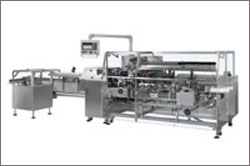KALIX’s KX2000 & KP2000 machines offer the whole package

KALIX has combined its experience with new technology to develop the new KX2000 tube filler and KP2000 cartoning machine. With this new technology, specially designed for the cosmetics industry, KALIX’s machines optimise flexibility, ergonomics, capacity and size, as well as facilitating packaging line cleaning and maintenance. KALIX will be present at the Interpack trade fair in Düsseldorf (Germany) from 21 to 27 April 2005.
The KX2000 tube filler can process plastic, aluminium, laminated, co-extruded or polyfoil tubes with volumes ranging from 2ml to 400ml. It achieves a mechanical rate of 200 tubes per minute, for an effective continuous production speed of 180 tubes/minute. The vertical storage module (VSM(r), KALIX patent), which saves considerable space, loads empty tubes into the KX2000. It can handle between 12 and 18 boxes of tubes.
The design of the KX2000 filler gives the operator complete accessibility to the various functions. All operations are controlled by drive motors, with automatic components controlled by an industrial PC, which stores format parameters and technical documentation. With a direct modem link, KALIX provides remote control facility for these machines.
Specially designed to meet the needs of increasing production rates in the cosmetics industry, the KP2000 continuous cartoning machine can process up to 200 cartons per minute in production. Filled and closed tubes are transferred by a manipulator which places the tube directly into the KP2000 continuous cartoning machine in a synchronised movement. This facility solves the problem of providing an interface between the filling machine and the cartoning machine, which is often a source of incidents and a resultant loss of productivity. Adjustment and maintenance are thus reduced to a minimum, the time needed to change a format without tools being around 15 minutes.
The KP2000’s multi-format capability means that it can process a wide range of cartons (with aeroplane or alternate flaps) by simple adjustment – from sample tube to colouring kit. The coding can be provided on all flaps, and tubes can be inserted with fold or cap first. The positive direction of carton insertion can be reversed if necessary, so it is easy to match carton/product surfaces. It takes about 15 minutes to change the format without the need for tools.
The machine’s balcony construction provides good accessibility to the core of the machine. Insertion is made from the back of the machine, which then provides total access to the carton line at the front and the functions connected to it (carton insertion, closure and marking). The leaflet distribution module can process prefolded leaflets or work in connection with a GUK machine (leaflets folder) for even greater autonomy. A new synchronised leaflet-placing unit simplifies the adjustment of this critical function.
The carton feed belt above the machine provides an effective loading length of 1500mm which can be extended to 2500mm as an optional extra.
The design of packaging lines with the KX2000 filler and KP2000 cartoning machines is much improved by the compactness of these machines and the direct positive tube transfer, which avoids the need for a connection module. Lines can be designed either in a straight line or square configuration, which optimises installation in the available space and gives the user a wider choice of possibilities.
Media Contact
All latest news from the category: Innovative Products
Newest articles

A universal framework for spatial biology
SpatialData is a freely accessible tool to unify and integrate data from different omics technologies accounting for spatial information, which can provide holistic insights into health and disease. Biological processes…

How complex biological processes arise
A $20 million grant from the U.S. National Science Foundation (NSF) will support the establishment and operation of the National Synthesis Center for Emergence in the Molecular and Cellular Sciences (NCEMS) at…

Airborne single-photon lidar system achieves high-resolution 3D imaging
Compact, low-power system opens doors for photon-efficient drone and satellite-based environmental monitoring and mapping. Researchers have developed a compact and lightweight single-photon airborne lidar system that can acquire high-resolution 3D…





















